Text
We’re all aflutter over the sea angel!
This swimming snail's rhythmic flapping and graceful movements resemble whimsical wings. The flappy bits you see sculling through the water aren’t wings at all—they’re basically a modified, slimy snail foot.
And despite its celestial appearance—the sea angel is a carnivorous hunter. With hidden tentacles tucked away inside its head, it tracks down prey and strikes!
2K notes
·
View notes
Text
A look into MBARI's video vault
This week, we’re sharing content curated by the team of experts responsible for our deep-sea video archive. Each member of the Video Lab Team has gone deep into the vault to find some of their favorite moments in MBARI’s history of ocean exploration. Get the inside scoop on some of the most interesting and unique observations they’ve made over the last few decades. Be sure to follow along all week as we share those moments with you!
In 36 years of deep-sea discoveries, MBARI’s remotely operated vehicles have completed more than 7,300 successful dives and recorded nearly 30,000 hours of deep-sea footage. This video archive includes more than 10 million observations about what we see on video—animals, behaviors, interactions, geological features, marine debris, and more—along with location, depth, and surrounding habitat characteristics. The Video Lab’s deep-sea experts comb through all of that footage with eagle eyes to identify and label animals and objects we film.
Learn more about the amazing team behind our stunning video!
144 notes
·
View notes
Text
Did you catch these cuties in our latest Deep Relaxocean video?
This black roughtail skate (Bathyraja trachura) is just one of the amazing animals featured in our latest episode. Skates are related to sharks. They have a distinct, flattened body, and they swim and glide using a pair of large, wing-like fins.
We often encounter skates resting on the sediment like this. Along with their expanded, muscular pectoral fins, some skates use their pelvic fins to maneuver while hunting along the bottom or to propel themselves off the seafloor when danger approaches.
Head over to our Animals of the Deep gallery and learn more about these spectacular skates.
64 notes
·
View notes
Text
#tfw you're too comfy to run away
Snailfishes are found globally in all ocean basins, from shallow intertidal waters to the deepest depths of the ocean to unsuspecting crabs that often serve as hosts to tiny snailfish eggs.
These slightly annoying but adorable fishes are well-adapted to a variety of habitats, including rocky outcrops, the muddy seafloor, and even the midwater. They play an important role as prey and predator in many ecosystems. Most snailfish species are small and feed on tiny invertebrates, but larger species may prey upon other fishes. MBARI has observed over a dozen species of snailfish in the past 34 years of exploration. We suspect there are dozens more out there waiting to be discovered.
Learn more about these overly-friendly fishes on our YouTube channel.
112 notes
·
View notes
Text
Twinkle twinkle little fish 🌟
The dollar hatchetfish (Sternoptyx diaphana) is about the size of a quarter. These tiny magicians can be found between 400 and 3,675 meters deep (1,312 to 12,057 feet). Light-producing organs in rows along their bellies help these little fish perform a deep-sea disappearing act.
Known as counterillumination, this adaptation allows the fish to match the daylight filtering from surface waters above and effectively hides the animal from predators that may be lurking below. Each species has a unique pattern of lights, and individuals can adapt their lights to whatever color is filtering down from the light above.
86 notes
·
View notes
Text
youtube
Unwind for six minutes with stunning footage of graceful deep-sea skates and rays filmed by MBARI’s underwater robots. Skates and rays are fishes related to sharks. They have a distinct, flattened body, and they swim and glide using a pair of large, wing-like fins. While we know a lot about the skates and rays that dwell in shallow coastal waters, we know relatively little about those that call the ocean’s inky depths their home.
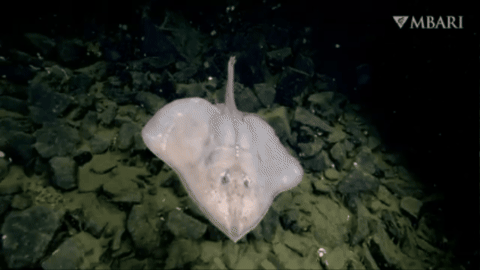
We often encounter skates resting on the sediment or skimming across the seafloor. Along with their expanded pectoral fins, some skates use their pelvic fins like legs to maneuver while hunting along the bottom or to propel themselves off the seafloor when danger approaches.
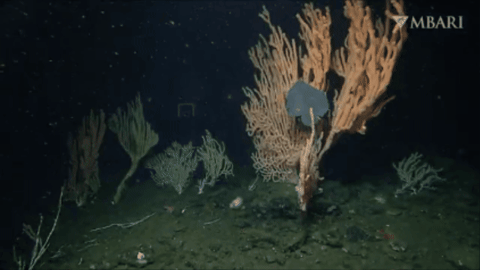
Our research is filling in the gaps in scientists’ baseline knowledge of rarely-seen deep-sea skate species. These data are especially important as climate change and overfishing continue to threaten biological communities. The more we learn about deep-sea sharks, skates, and rays, the better we can protect them and their habitats.
Learn more about deep-sea skates on our website.
209 notes
·
View notes
Text
Peep this deep-sea jelly, pretty in pinks and purples. But don’t be deceived by its petite size — the mauve stinger can pack a punch with stinging cells peppered across its tentacles and bell.
1K notes
·
View notes
Text
Meet the gulper eel
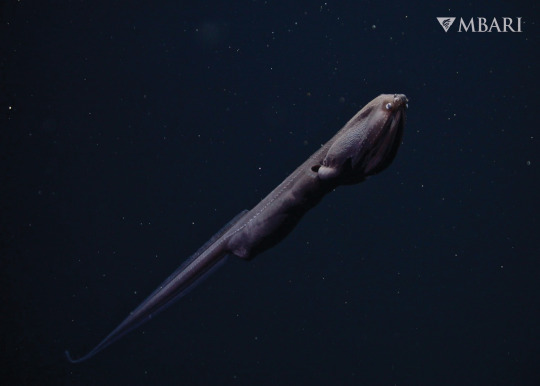
MBARI has studied the deep waters of Monterey Bay and beyond for more than 30 years. In our thousands of dives to these dark depths, we’ve only seen this species seven times.
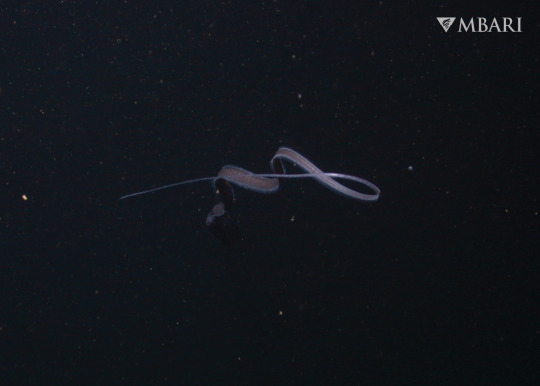
Gulper eels reach a maximum size of one meter and live between 300 and 2,000 meters deep.
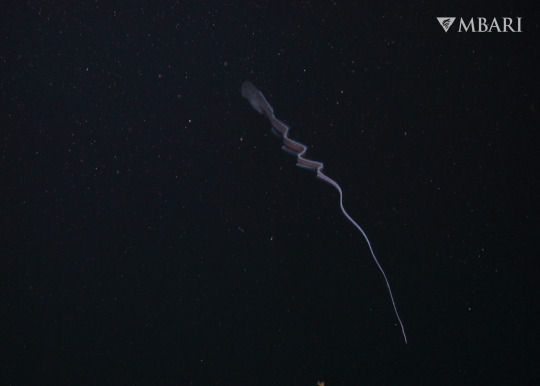
Learn more on our website.
848 notes
·
View notes
Text
Things you should give your mom for Mother’s Day—fancy jewelry, a bouquet of her favorite flowers, a nicely scented candle.
Things you shouldn’t give your mom for Mother’s Day—balloons that might end up in the ocean, expired cheese, that candle you got for Christmas from your aunt last year that's been sitting at the back of your closet until now.
As we celebrate the holiday, let’s reduce our reliance on single-use plastics (like balloons) and keep trash out of the ocean.
Learn more about trash in the deep sea on our website.
100 notes
·
View notes
Text
It's been a while so here's another deep-sea animal you've never heard of—the bottle comb jelly.
This species, Aulacoctena acuminate, was observed by our remotely operated vehicle Doc Ricketts at 1,146 meters (3,760 feet) deep. These comb jellies are ctenophores, not true jellies. Like other comb jellies, they navigate through the water by beating their shimmering, hair-like cilia.
MBARI researchers have learned that gelatinous animals like the bottle comb jelly have a large impact on deep-sea food webs. Our archive of nearly 28,000 hours of deep-sea video contains hundreds of observations of deep-sea animals feeding. Examining these observations in detail revealed that jellies, comb jellies, and siphonophores are important as both predators and prey in the ocean’s midnight zone.
Learn all about comb jellies and their deep-sea relatives in our Animals of the Deep gallery.
105 notes
·
View notes
Text
Spotted: an octopus playing the floor is lava 🐙🌋
Pillow lavas look like rounded blobs of solidified lava. They are formed as lava pours slowly out of the seafloor, and cold seawater cools the outer edge very quickly. Think about squeezing toothpaste out of a tube, but instead of it flowing freely, the outer skin of the toothpaste hardens as soon as it touches air. Pillow lavas come in various sizes and shapes, and each of these shapes can tell us a bit about the eruption that formed them.
Watch more video footage of these amazing geological formations on our YouTube channel.
9 notes
·
View notes
Text
Spotted: everyone's new favorite worm. 🐽🍑
This stubby celebrity is trending across the interwebs and we can see why! Our team first spotted the unusual pigbutt worm (Chaetopterus pugaporcinus) in 2001 and had a tough time determining how to categorize such a curious and tiny critter. At about the size of a hazelnut, it took the eagle eyes of our expert biologists to spot these miniature orbs in the massive ocean.
In the lab, we saw that Chaetopterus pugaporcinus is segmented like other bristle worms. However, the segments are highly compressed in the front and back ends, while the midsection is greatly inflated, probably to help keep the animal afloat. Sequencing the pigbutt’s DNA established that they fit into the family Chaetopteridae. Members of this group of worms typically live attached to the seafloor in parchment-like tubes, although they do have a free-swimming larval stage. The mix of both larval and adult features seen in the pigbutt worm is certainly unusual.
And if that wasn't extraordinary enough, we also learned that these incredible worms are bioluminescent! They produce blue light in their body tissues as well as green glowing mucous secretions, an adaptation that may be used to deter predators.
Learn more about these wonderful worms on our website.
93 notes
·
View notes
Text
Spending some quality time with the sparkly squid, Taonius borealis. 🦑🌠
Glass squids (family Cranchiidae) live in the boundless waters of the twilight, or mesopelagic, zone. With no protective shell and nowhere to shelter, they use transparency to thrive in a home with few places to hide.
More than 60 species of glass squids live in deep twilight waters around the world. Some are little more than 10 centimeters (four inches) long, but others are giants. In fact, the largest of all squids—the colossal squid (Mesonychoteuthis hamiltoni), nearly 10 meters (33 feet) long and weighing up to 495 kilograms (1,091 pounds)—belongs to the family Cranchiidae. We typically see smaller species like this peacock squid because the larger ones are faster swimmers that can easily elude our slow-moving submersibles.
Learn more about these splendid squids on our website.
177 notes
·
View notes
Text
La vie en rose 💕
MBARI's remotely operated vehicle observed these brilliant basket stars on Davidson Seamount at 1,498 meters (4,915 feet) deep. Basket stars (Gorgonocephalus eucnemis) are common at seamounts. These underwater mountains deflect the currents running along the deep seafloor, concentrating food and supporting a rich community of life.
A basket star’s repeatedly branching arms bear microscopic hooks and secrete sticky mucus to help grab planktonic prey. After snagging a morsel of food, the arm curls into a tight knot and passes it to the mouth beneath the star’s central disc.
Learn more about these sensational stars on our website.
102 notes
·
View notes
Text
youtube
Welcome to FathomVerse 🦑🐟🦀
A new mobile game launching today allows anyone with a smartphone or tablet to take part in ocean exploration and discovery. Now available for download on the App Store and Google Play, FathomVerse allows players to interact with real underwater images to improve the artificial intelligence that helps researchers study ocean life.

Scientists are collecting massive amounts of images and video to study marine life and assess ocean health. AI can help researchers analyze this deluge of visual data more efficiently. Before AI can be used for ocean exploration, machine learning models need to be trained to identify ocean animals.
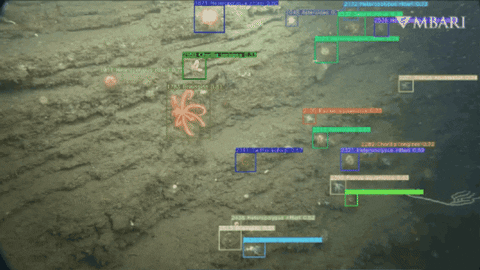
FathomVerse seeks to address this challenge by engaging ocean enthusiasts around the world to help review and label images so AI can correctly recognize ocean animals. The game combines immersive imagery, compelling gameplay, and cutting-edge science to inspire a new wave of ocean explorers. Learn more on our website.
307 notes
·
View notes
Text
It's time for everyone's favorite guessing game—who's eating whom?
Is it the little jelly Aegina snacking on a much larger siphonophore? Or did the siphonophore snag a delicious deep-sea dinner?
71 notes
·
View notes